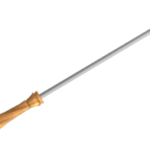The Pennsylvania Dutch dialect is an unprecedented dialect, remaining preserved and true to its original form throughout its evolution from the time of the original thirteen colonies until the present. While some minor adjustments have been made to improve the overall ability to comprehend the language, grammar and sentence structure have been carried over from German linguistics.
As settlers began pouring into the “New World” in the late 1600s, America truly became a melting pot. Consequently, cultures became lumped together by their geographical closeness, and individuals from Bavaria, Prussia, Holland, Switzerland, and Tyrol were all labeled as “Dutch” (Follin 455). As a result, Pennsylvania Dutch was formed, becoming the vernacular for these early settlers. Different from the “Hoch Deutsch,” or High German, Pennsylvania Dutch was spoken primarily by member of the peasant class. In their eyes, it was one thing that they could reserve for themselves, and the dialect served as a uniting factor among the class.
Although the dialect is often referred to as “bad German and worse English,” Pennsylvania Dutch has perpetuated the characteristics of Rheinpfälzisch, the Rhine Palatinate. In fact, early settlers were forced to borrow terms from the English language not only as a means of describing ideas that they neglected to have words for, but also as a means of enriching their vocabulary (Learned 179).
Such themes have remained preserved from century to century. Naturally, Pennsylvania Dutch has become more softened and more slurred; however, this has most likely occurred as a result of the fact that there exists no publications and little to no written record of the dialect and its evolution (Follin455). As the majority of the people who developed Pennsylvania Dutch were illiterate, there was no way to account for the language in its earliest stages, and the language was passed down merely through word of mouth and storytelling.
Although native Pennsylvanians are rarely fluent in Pennsylvania Dutch at the present, from York and Lancaster Counties to Lehigh and Carbon Counties, one can observe traces of Pennsylvania Dutch that have been assimilated into everyday English. For instance, instead of saying “What type of music do you like?” one might say “What for music do you like?” which comes from “Was für” of the German language.
In terms of the Pennsylvania Dutch dialect in itself, research among secular and sectarian speakers has found that the language is gradually dying out secular speakers. To this day, however, Pennsylvania Dutch is the “mother tongue” of Amish and Mennonite communities (Fuller 38). Furthermore, the dialect are far outlived the standard longevity of patterns for immigrant languages.
It is these characteristics, however, that make Pennsylvania Dutch so fascinating. How one dialect, so informal and so poorly recorded can possibly remain so precisely preserved and simultaneously manage to influence the English language as well is simply unparalleled. From past participles to patterns verb conjugation and the use of reflexive pronouns, Pennsylvania Dutch incorporates a multitude of German language patterns into its grammatical guidelines.
For instance, the required endings for modifiers remain true to High German in all gender cases of the accusative, nominative and dative. This can be seen in the prepositional phrase “in the same church,” (Reed 241). To translate this into Pennsylvania Dutch, one would say “in der same Karrich,” using the masculine form of the definite article to coincide with its following of the two-way German preposition.
Furthermore, verb conjugations of newly incorporated words as well as native German words are broken down in traditional High German fashion. For example, to conjugate the infinitive “kige,” meaning to kick, one would say “ich kige,” and the pattern would continue onward in coincidence with standard German conjugation patterns.
This is also true in conjugation of verbs into the past tense. There is no preterit tense in Pennsylvania Dutch, so verbs are conjugated as they would be in the standard German past perfect tense. Depending on the classification of the verb, it will be accompanied either by the modal auxiliary verb “sei” from the German “sein,” meaning “to be,” or by the auxiliary verb “hawe” from the German “haben,” meaning “to have,” (Reed 242). For example, “Ich bin ni gajoomped,” means “I jumped in.”
Similarly, when compound verbs are borrowed from English, prefixes are either completely translated or simply phonetically adapted. With the verb phrase “sobered up,” for instance, there is a grammatical need to employ the German grammatical rule of a separable prefix. Thus, the phrase would be translated as “uff g’sobered,” (Reed 244).
In examining the relationship of reflexive verbs and their corresponding pronouns, one will discover that the rules in Pennsylvania Dutch are completely compliant to those of High German. For instance, the statement “I enjoy myself,” obviously requires the use of a reflexive pronoun. Thus, the German sentence “Ich genieße mich,” would be translated into Pennsylvania Dutch as “Ich enjoy mich,” (Reed 243).
For the most part, Pennsylvania Dutch grammar complies strictly to High German, and consequently, syntactical confusion can sometimes occur as a result of the intermingling of two languages that are so grammatically different. While one’s point can still be comprehended, there is no real way to express semantic variation (Reed 245). For instance, in German and in Pennsylvania Dutch a gerund is expressed by the use of an infinitive. To say “Hiking is fun,” for instance, one would say “Wandern macht Spaß,” which is translated as “To hike is fun.”
Many will find that with a fluency in English and German, it is rather easy to understand the Pennsylvania Dutch language. In coming into contact with the Amish population, one will be able to understand at very least bits and pieces of their speech. Examining writing in Pennsylvania Dutch is a bit more complex, simply because the spelling of words is so synthetic.
Ultimately, the Pennsylvania Dutch dialect has achieved an unprecedented level of longevity among other immigrant languages. Most often, languages would simply die out as they became increasingly Americanized; however, Pennsylvania Dutch is still the first language of several sectarian groups, and it has forever impacted the vernacular of many secular Pennsylvanians. Bibliography
Brendle, Thomas R. Pennsylvania German Folk Tales, Legends, Once-upon-a-time Stories, Maxims and Sayings Spoken in the Dialect Popularly Known as Pennsylvania Dutch. Norristown, PA: Pennsylvania German Society, 1944. Print.
Frey, J. William. Pennsylvania Dutch Grammar. Lancaster, PA: Pennsylvania Folklike Society, 1961. Print.
Haag, Earl C. A Pennsylvania German Reader and Grammar. University Park, PA: Pennsylvania State University Press, 1982. Print.
Secondary Resources:
Follin, Maynard D. “Pennsylvania Dutch.” American Speech. August 1929: 455 – 458. Print.
Fuller, Janet M. “The Role of English in Pennsylvania Dutch Grammar.” American Speech. Spring 1991: 38 – 55. Print.
Learned, M.D. “The Pennsylvania German Dialect.” The American Journal of Philology. Volume 9, Number 2. Johns Hopkins University Press: 1888. Reed, Carroll E. The Adaptation of English to Pennsylvania German Morphology.” American Speech. October 1948: 239 – 244. Print.


